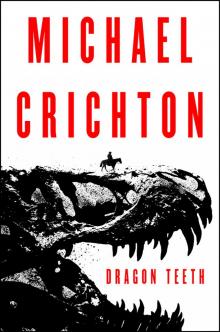- Home
- Michael Crichton
Jurassic Park
Jurassic Park Read online
“A TAUT THRILLER …
FASCINATING …
Crichton is a master at blending edge-of-the-chair adventure and a scientific seminar, educating his readers as he entertains them.”
—St. Louis Post-Dispatch
“Crichton combines his knowledge of science with a great talent for creating suspense.… Fast-moving.”
—San Francisco Chronicle
“Crichton is remarkably realistic with his depictions of what it could be like if genetic engineering created a theme park full of carefully modified dinosaurs—and the terrible lizards got out of control.”
—USA Today
“Crichton’s notion is wonderful precisely because nothing about it is entirely outside the realm of possibility.… He presents an astonishingly plausible case that a lot of money and a little bit of luck are all one would need to make this book’s unlikely scenario become real.”
—The Cleveland Plain Dealer
“Intellectually provocative, high-octane entertainment.”
—New York Newsday
“AN EXCITING, FAST-PACED
TALE THAT’S HARD TO
PUT DOWN.”
—Milwaukee Journal
“Riveting … A winning blend of action, suspense, and information.”
—Detroit Free Press
“Exciting … Frightening.”
—The New York Times
“Ingenious … JURASSIC PARK is hard to beat for sheer intellectual entertainment.”
—Entertainment Weekly
“A winner … Highly entertaining … Michael Crichton has written a thriller combining sophisticated biotechnology with prehistoric legend. And what a thriller it is.”
—St. Petersburg Times
“[A] DEFT SCIENTIFIC
THRILLER … A SNAPPY
NIGHTMARE OF SCIENCE
RUN AMOK.”
—The Wall Street Journal
“Crichton’s dinosaurs are genuinely frightening.”
—Chicago Sun-Times
“Crichton’s sci-fi is convincingly detailed.”
—Time Magazine
“Vastly entertaining … [A] tornado-paced tale … Easily the most exciting dinosaur novel ever written. A sure-fire bestseller.”
—Kirkus Reviews
“A scary, creepy, mesmerizing techno-thriller with teeth.”
—Publishers Weekly
“By far the best science fiction I have read since Jules Verne in my youth.”
—John Barkham Review
A Ballantine Book
Published by The Random House Publishing Group
Copyright © 1990 by Michael Crichton
All rights reserved.
Published in the United States by Ballantine Books, an imprint of The Random House Publishing Group, a division of Random House, Inc., New York, and simultaneously in Canada by Random House of Canada Limited, Toronto.
Ballantine and colophon are registered trademarks of Random House, Inc.
www.ballantinebooks.com
Library of Congress Catalog Card Number: 90-52960
eISBN: 978-0-307-76305-1
The edition published by arrangement with Alfred A. Knopf, Inc.
v3.1_r1
Contents
Cover
Title Page
Copyright
Epigraph
Introduction
Prologue: The Bite of the Raptor
First Iteration Almost Paradise
Puntarenas
The Beach
New York
The Shape of the Data
Second Iteration The Shore of the Inland Sea
Skeleton
Cowan, Swain and Ross
Plans
Hammond
Choteau
Target of Opportunity
Airport
Malcolm
Isla Nublar
Welcome
Third Iteration Jurassic Park
When Dinosaurs Ruled the Earth
The Tour
Control
Version 4.4
Control
The Tour
Control
Big Rex
Control
Stegosaur
Control
Breeding Sites
Fourth Iteration The Main Road
Return
Nedry
Bungalow
Tim
Lex
Control
The Road
Control
In the Park
Control
The Park
Dawn
The Park
Fifth Iteration Search
Aviary
Tyrannosaur
Control
Sixth Iteration Return
The Grid
Lodge
Control
Seventh Iteration Destroying the World
Under Control
Almost Paradigm
Descent
Hammond
The Beach
Approaching Dark
Epilogue: San José
Dedication
Acknowledgments
Books by Michael Crichton
About the Author
“Reptiles are abhorrent because of their cold body, pale color, cartilaginous skeleton, filthy skin, fierce aspect, calculating eye, offensive smell, harsh voice, squalid habitation, and terrible venom; wherefore their Creator has not exerted his powers to make many of them.”
LINNAEUS, 1797
“You cannot recall a new form of life.”
ERWIN CHARGAFF, 1972
INTRODUCTION
“The InGen Incident”
The late twentieth century has witnessed a scientific gold rush of astonishing proportions: the headlong and furious haste to commercialize genetic engineering. This enterprise has proceeded so rapidly—with so little outside commentary—that its dimensions and implications are hardly understood at all.
Biotechnology promises the greatest revolution in human history. By the end of this decade, it will have outdistanced atomic power and computers in its effect on our everyday lives. In the words of one observer, “Biotechnology is going to transform every aspect of human life: our medical care, our food, our health, our entertainment, our very bodies. Nothing will ever be the same again. It’s literally going to change the face of the planet.”
But the biotechnology revolution differs in three important respects from past scientific transformations.
First, it is broad-based. America entered the atomic age through the work of a single research institution, at Los Alamos. It entered the computer age through the efforts of about a dozen companies. But biotechnology research is now carried out in more than two thousand laboratories in America alone. Five hundred corporations spend five billion dollars a year on this technology.
Second, much of the research is thoughtless or frivolous. Efforts to engineer paler trout for better visibility in the stream, square trees for easier lumbering, and injectable scent cells so you’ll always smell of your favorite perfume may seem like a joke, but they are not. Indeed, the fact that biotechnology can be applied to the industries traditionally subject to the vagaries of fashion, such as cosmetics and leisure activities, heightens concern about the whimsical use of this powerful new technology.
Third, the work is uncontrolled. No one supervises it. No federal laws regulate it. There is no coherent government policy, in America or anywhere else in the world. And because the products of biotechnology range from drugs to farm crops to artificial snow, an intelligent policy is difficult.
But most disturbing is the fact that no watchdogs are found among scientists themselves. It is remarkable that nearly every scientist in genetics research is
also engaged in the commerce of biotechnology. There are no detached observers. Everybody has a stake.
The commercialization of molecular biology is the most stunning ethical event in the history of science, and it has happened with astonishing speed. For four hundred years since Galileo, science has always proceeded as a free and open inquiry into the workings of nature. Scientists have always ignored national boundaries, holding themselves above the transitory concerns of politics and even wars. Scientists have always rebelled against secrecy in research, and have even frowned on the idea of patenting their discoveries, seeing themselves as working to the benefit of all mankind. And for many generations, the discoveries of scientists did indeed have a peculiarly selfless quality.
When, in 1953, two young researchers in England, James Watson and Francis Crick, deciphered the structure of DNA, their work was hailed as a triumph of the human spirit, of the centuries-old quest to understand the universe in a scientific way. It was confidently expected that their discovery would be selflessly extended to the greater benefit of mankind.
Yet that did not happen. Thirty years later, nearly all of Watson and Crick’s scientific colleagues were engaged in another sort of enterprise entirely. Research in molecular genetics had become a vast, multibillion-dollar commercial undertaking, and its origins can be traced not to 1953 but to April 1976.
That was the date of a now famous meeting, in which Robert Swanson, a venture capitalist, approached Herbert Boyer, a biochemist at the University of California. The two men agreed to found a commercial company to exploit Boyer’s gene-splicing techniques. Their new company, Genentech, quickly became the largest and most successful of the genetic engineering start-ups.
Suddenly it seemed as if everyone wanted to become rich. New companies were announced almost weekly, and scientists flocked to exploit genetic research. By 1986, at least 362 scientists, including 64 in the National Academy, sat on the advisory boards of biotech firms. The number of those who held equity positions or consultancies was several times greater.
It is necessary to emphasize how significant this shift in attitude actually was. In the past, pure scientists took a snobbish view of business. They saw the pursuit of money as intellectually uninteresting, suited only to shopkeepers. And to do research for industry, even at the prestigious Bell or IBM labs, was only for those who couldn’t get a university appointment. Thus the attitude of pure scientists was fundamentally critical toward the work of applied scientists, and to industry in general. Their long-standing antagonism kept university scientists free of contaminating industry ties, and whenever debate arose about technological matters, disinterested scientists were available to discuss the issues at the highest levels.
But that is no longer true. There are very few molecular biologists and very few research institutions without commercial affiliations. The old days are gone. Genetic research continues, at a more furious pace than ever. But it is done in secret, and in haste, and for profit.
In this commercial climate, it is probably inevitable that a company as ambitious as International Genetic Technologies, Inc., of Palo Alto, would arise. It is equally unsurprising that the genetic crisis it created should go unreported. After all, InGen’s research was conducted in secret; the actual incident occurred in the most remote region of Central America; and fewer than twenty people were there to witness it. Of those, only a handful survived.
Even at the end, when International Genetic Technologies filed for Chapter 11 protection in United States Bankruptcy Court in San Francisco on October 5, 1989, the proceedings drew little press attention. It appeared so ordinary: InGen was the third small American bioengineering company to fail that year, and the seventh since 1986. Few court documents were made public, since the creditors were Japanese investment consortia, such as Hamaguri and Densaka, companies which traditionally shun publicity. To avoid unnecessary disclosure, Daniel Ross, of Cowan, Swain and Ross, counsel for InGen, also represented the Japanese investors. And the rather unusual petition of the vice consul of Costa Rica was heard behind closed doors. Thus it is not surprising that, within a month, the problems of InGen were quietly and amicably settled.
Parties to that settlement, including the distinguished scientific board of advisers, signed a nondisclosure agreement, and none will speak about what happened; but many of the principal figures in the “InGen incident” are not signatories, and were willing to discuss the remarkable events leading up to those final two days in August 1989 on a remote island off the west coast of Costa Rica.
PROLOGUE: THE BITE OF THE
RAPTOR
The tropical rain fell in drenching sheets, hammering the corrugated roof of the clinic building, roaring down the metal gutters, splashing on the ground in a torrent. Roberta Carter sighed, and stared out the window. From the clinic, she could hardly see the beach or the ocean beyond, cloaked in low fog. This wasn’t what she had expected when she had come to the fishing village of Bahía Anasco, on the west coast of Costa Rica, to spend two months as a visiting physician. Bobbie Carter had expected sun and relaxation, after two grueling years of residency in emergency medicine at Michael Reese in Chicago.
She had been in Bahía Anasco now for three weeks. And it had rained every day.
Everything else was fine. She liked the isolation of Bahía Anasco, and the friendliness of its people. Costa Rica had one of the twenty best medical systems in the world, and even in this remote coastal village, the clinic was well maintained, amply supplied. Her paramedic, Manuel Aragón, was intelligent and well trained. Bobbie was able to practice a level of medicine equal to what she had practiced in Chicago.
But the rain! The constant, unending rain!
Across the examining room, Manuel cocked his head. “Listen,” he said.
“Believe me, I hear it,” Bobbie said.
“No. Listen.”
And then she caught it, another sound blended with the rain, a deeper rumble that built and emerged until it was clear: the rhythmic thumping of a helicopter. She thought, They can’t be flying in weather like this.
But the sound built steadily, and then the helicopter burst low through the ocean fog and roared overhead, circled, and came back. She saw the helicopter swing back over the water, near the fishing boats, then ease sideways to the rickety wooden dock, and back toward the beach.
It was looking for a place to land.
It was a big-bellied Sikorsky with a blue stripe on the side, with the words “InGen Construction.” That was the name of the construction company building a new resort on one of the offshore islands. The resort was said to be spectacular, and very complicated; many of the local people were employed in the construction, which had been going on for more than two years. Bobbie could imagine it—one of those huge American resorts with swimming pools and tennis courts, where guests could play and drink their daiquiris, without having any contact with the real life of the country.
Bobbie wondered what was so urgent on that island that the helicopter would fly in this weather. Through the windshield she saw the pilot exhale in relief as the helicopter settled onto the wet sand of the beach. Uniformed men jumped out, and flung open the big side door. She heard frantic shouts in Spanish, and Manuel nudged her.
They were calling for a doctor.
Two black crewmen carried a limp body toward her, while a white man barked orders. The white man had a yellow slicker. Red hair appeared around the edges of his Mets baseball cap. “Is there a doctor here?” he called to her, as she ran up.
“I’m Dr. Carter,” she said. The rain fell in heavy drops, pounding her head and shoulders. The red-haired man frowned at her. She was wearing cut-off jeans and a tank top. She had a stethoscope over her shoulder, the bell already rusted from the salt air.
“Ed Regis. We’ve got a very sick man here, doctor.”
“Then you better take him to San José,” she said. San José was the capital, just twenty minutes away by air.
“We would, but we can’t get over the
mountains in this weather. You have to treat him here.”
Bobbie trotted alongside the injured man as they carried him to the clinic. He was a kid, no older than eighteen. Lifting away the blood-soaked shirt, she saw a big slashing rip along his shoulder, and another on the leg.
“What happened to him?”
“Construction accident,” Ed shouted. “He fell. One of the backhoes ran over him.”
The kid was pale, shivering, unconscious.
Manuel stood by the bright green door of the clinic, waving his arm. The men brought the body through and set it on the table in the center of the room. Manuel started an intravenous line, and Bobbie swung the light over the kid and bent to examine the wounds. Immediately she could see that it did not look good. The kid would almost certainly die.
A big tearing laceration ran from his shoulder down his torso. At the edge of the wound, the flesh was shredded. At the center, the shoulder was dislocated, pale bones exposed. A second slash cut through the heavy muscles of the thigh, deep enough to reveal the pulse of the femoral artery below. Her first impression was that his leg had been ripped open.
“Tell me again about this injury,” she said.
“I didn’t see it,” Ed said. “They say the backhoe dragged him.”
“Because it almost looks as if he was mauled,” Bobbie Carter said, probing the wound. Like most emergency room physicians, she could remember in detail patients she had seen even years before. She had seen two maulings. One was a two-year-old child who had been attacked by a rottweiler dog. The other was a drunken circus attendant who had had an encounter with a Bengal tiger. Both injuries were similar. There was a characteristic look to an animal attack.
“Mauled?” Ed said. “No, no. It was a backhoe, believe me.” Ed licked his lips as he spoke. He was edgy, acting as if he had done something wrong. Bobbie wondered why. If they were using inexperienced local workmen on the resort construction, they must have accidents all the time.

 Dragon Teeth
Dragon Teeth Jurassic Park
Jurassic Park Micro
Micro The Great Train Robbery
The Great Train Robbery The Andromeda Strain
The Andromeda Strain The Lost World
The Lost World Congo
Congo Travels
Travels Timeline
Timeline Sphere
Sphere Westworld
Westworld Prey
Prey State Of Fear
State Of Fear Next
Next Disclosure
Disclosure Pirate Latitudes
Pirate Latitudes The Terminal Man
The Terminal Man Five Patients
Five Patients Rising Sun
Rising Sun Binary
Binary The Andromeda Evolution
The Andromeda Evolution Airframe
Airframe Easy Go
Easy Go Drug of Choice
Drug of Choice Odds On: A Novel
Odds On: A Novel Scratch One
Scratch One Dealing or The Berkeley-to-Boston Forty-Brick Lost-Bag Blues
Dealing or The Berkeley-to-Boston Forty-Brick Lost-Bag Blues Venom Business
Venom Business Grave Descend
Grave Descend Gold - Pirate Latitudes
Gold - Pirate Latitudes Binary: A Novel
Binary: A Novel Zero Cool
Zero Cool Delos 1 - Westworld
Delos 1 - Westworld